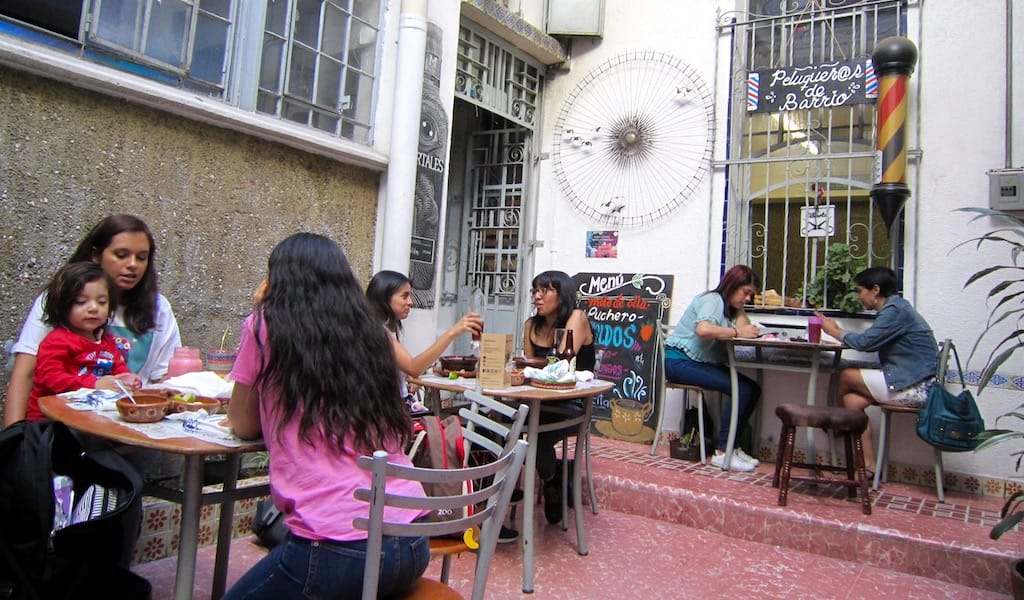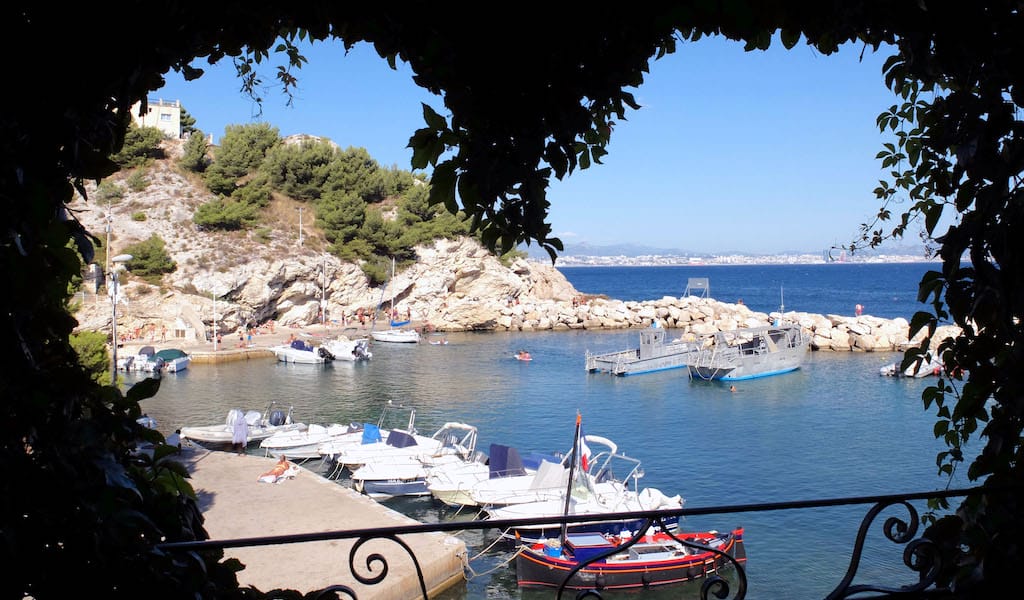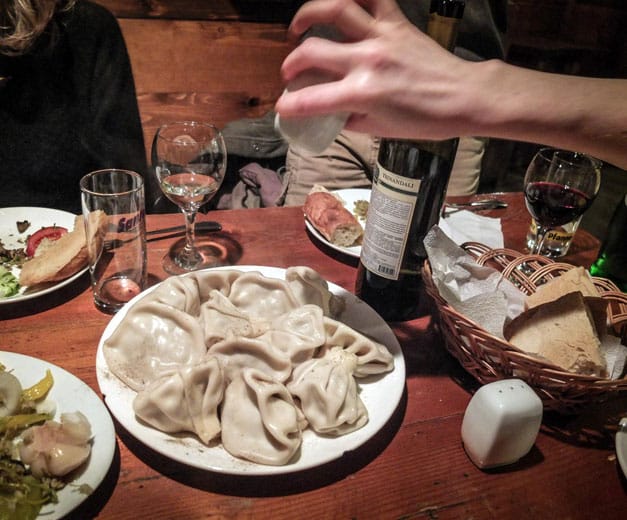Update: This spot is sadly no longer open.
We grew up in a household where drinking soup directly from the bowl was frowned upon, done only surreptitiously when Mom was looking away or as an act of impish rebellion, a bold unshackling from the spoon and its torment.
Yet it took little prodding from Isis Iturriaga, founder and proprietor of Sanadoras La Caldería, to lift our earthenware bowl with both hands to eager lips and down the last of our impeccable caldo de hongos (mushroom soup) in three great gulps.
“You are in your home,” she reiterated as the chipotle-infused liquid began to spark our insides. This is her mantra for the place, a plinth at the core of her being.
More a command than suggestion, there’s something of left-handed magic at work when she speaks it, something of the iron will woven into Sanadoras – an audacious experiment in social responsibility and Slow Food built upon a quintet of classic home-style Mexican soups. (Two are beef-based, two chicken-based and then there is the vegan mushroom soup.)
Isis, who formerly worked in set construction for theater, film and other large-scale projects, opened the place in August 2015 as something of a vision quest. “I think it’s one of those 40s things – change of life, of destiny, you know, all of that madness, I just said ‘I’m going to open my caldería,’” she explained.

After scouting locations in the capital’s hipster corridors of Roma and Navarte, where options were expensive yet small, she heard about a large property available on Fray Servando in the Merced neighborhood and decided to check it out.
“When I got there I told myself, ‘This is it,’” Isis said.
With seating in the atrium and an adjacent room, the caldería serves as anchor to an ever-evolving menagerie of microbusinesses – a mezcalería, a pulque bar, a chocolatería, a barbershop, a thrift shop and, on the upper levels, various workshops used by artists and creative types for cultural production. “It’s a project of projects,” she said.
For Isis, the caldería serves as an exercise in cultural responsibility, one that’s infused with Slow Food principles. All of the meat and other ingredients are sourced locally from nearby markets, always fresh and never packaged or frozen. Conveniently, the sprawling Merced Market is just a few blocks away.
She noted that no plastic, Styrofoam or napkins are used, and that if we wanted a second soup to take home, we’d have to come up with our own container, which we promptly ventured out to buy.
Isis added that she casts a wide net and focuses on underrepresented communities when it comes to staffing – the women in her kitchen include some who are indigenous and speak little to no Spanish, one with nine children and another who was a former convict.
On our foray into the kitchen, a few of the ladies scattered when they saw our camera, breaking into laughter. One of the brave ones, Isabel, an elderly but vibrant woman was game, pulling Martina, another cook, into frame – or attempting to anyway. Chatting with us while cleaning up, they were genuinely enthused about the chance to work at the restaurant, adding that they believe the project does a lot of good.
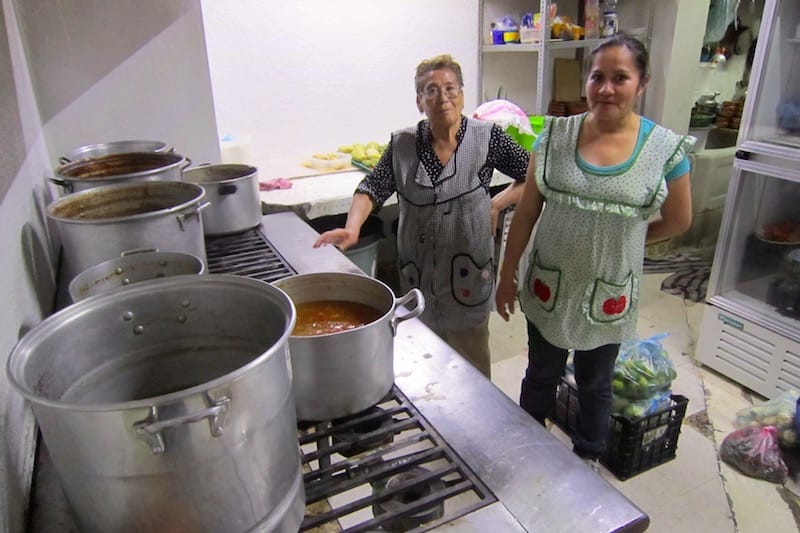
It seems no coincidence that Sanadoras, which means “healers” in Spanish, is located a stone’s throw from Mexico City’s witchcraft market – the Mercado Sonora, a one-stop shop for all things magical. Shamans, fortune tellers, healers, herbalists and, of course, brujas and brujos (witches and warlocks) are on standby for all your ritual and spell-casting needs.
For us, Sonora is creepy, not least because of the exotic animal trade that takes place in the market. A nice hot bowl of soup at Sanadoras – a different type of potion to ease the soul – sounds just about right to shake off any lingering chill from the dark vibe at Sonora.
“It’s about coming home,” Isis said, “It’s the food from our mothers.”
Mexican caldos, it must be noted, can be labor intensive. Here veggies are typically chopped into large chunks made for multiple bites; beef can come in fist-sized hunks; and chicken legs go in whole, skin, gristle and all. With this kind of preparation, there is no doubt the meat is real and unprocessed, and that human hands cut every carrot, every potato.
“It’s slow food, take it or leave it.”
While fork and knife might seem an effective angle of attack at the outset, veterans manage brilliantly with only a spoon in one hand and a corn tortilla in the other. If you find this tricky, let others lead by example.
On this most recent visit, we tried using the tortillas that come with the caldo de hongos, which featured a mix of white and oyster mushrooms (the latter, known as setas locally, are vital to the composition of a traditional Mexican mushroom soup), to thin out the herd of ingredients a bit.
Isis explained that their tortillas are the real deal, that is to say they undergo the process known as nixtamalization, where the corn grains are soaked and heated in an alkaline solution, traditionally limewater, before being washed, hulled, ground and made into tortillas. The process, a brilliant pre-Hispanic technology from Mesoamerica, greatly enhances both the nutritional value of the corn and the aroma, while reducing fungal toxins. It’s also, sadly, becoming a rarity in Mexico, with households, street vendors and fondas often opting to use cheap, processed alternatives.
With the large chunks mostly polished off, we washed down the last layer of liquid from the bowl – the broth tasted strongly of the seasonings, in this case a blend of chiles and spices, rather than salt, an outcome that relies on fresh ingredients and patient preparation. Our core was warm, our face sweating, and we were on the whole quite satisfied.
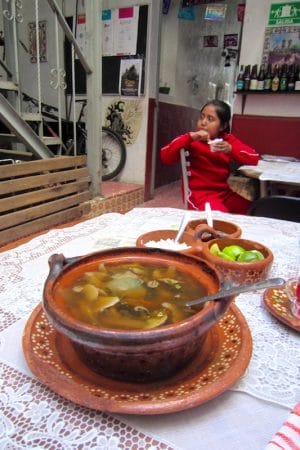 Before leaving, we ordered the caldo mole de olla, one of the two beef options (the puchero being the other), to go for our evening meal. The most popular option at the restaurant, the mole de olla has a rich, thick broth that offers a slow but never overwhelming heat. The freshness of the carrots and potatoes came through with the taste, and the veggies were cooked evenly, soft but firm. Likewise, the stewed beef was buttery, and beyond some gristle and fat, the meat yielded nicely to the bite.
Before leaving, we ordered the caldo mole de olla, one of the two beef options (the puchero being the other), to go for our evening meal. The most popular option at the restaurant, the mole de olla has a rich, thick broth that offers a slow but never overwhelming heat. The freshness of the carrots and potatoes came through with the taste, and the veggies were cooked evenly, soft but firm. Likewise, the stewed beef was buttery, and beyond some gristle and fat, the meat yielded nicely to the bite.
Isis’ favorite, however, is the caldo grosero, one of two chicken soups. (The other poultry option, the caldo tlapeño, is similar but with a bit more heat, making it a good hangover cure.) All five options are generously portioned and incredibly affordable at just 60 pesos (US$3) per bowl.
Drinks are similarly inexpensive; a cup of one of the various aguas frescas, water infused with fruit, flowers, spices or even vegetables, is 20 pesos and comes with free refills (an unusual perk).
Isis told us that the place sees a broad range of clientele, including visiting foreigners and office workers that crowd in for the weekday comida (lunch) rush. Yet the spot’s popularity has led to grumbling about long wait times and slow service. “It’s slow food, take it or leave it,” Isis answered plainly when we asked her about it.
She pointed out that space is limited and most customers do not complain, even when lines form out to the sidewalk. Those impatient souls who do kick up a fuss are missing the point of the experience, she explained.
“We would rather lose a bad customer than not maintain what we are,” Isis told us defiantly. Real soup takes time to consume and should never be rushed.
 August 5, 2020 La Pergola
August 5, 2020 La Pergola
If you ask a Marseillais where to cavort on the coast, most will respond, without […] Posted in Marseille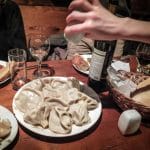 April 1, 2015 The Khinkali Chronicles
April 1, 2015 The Khinkali Chronicles
It was in 2007, when, on a hunger-induced whim, we called a friend and asked him to meet […] Posted in Tbilisi May 13, 2014 Galaktoboureko
May 13, 2014 Galaktoboureko
There is a certain rite of passage associated with being invited to dinner or coffee at […] Posted in Athens
Published on March 11, 2019
Related stories
August 5, 2020
MarseilleIf you ask a Marseillais where to cavort on the coast, most will respond, without hesitation, “the Calanques”: turquoise coves tucked between towering limestone cliffs that can only be reached by foot, boat or paddle. Spanning Marseille and Cassis, this national park gets all the glory – and tourist campaigns – for its jaw-dropping grandeur.…
April 1, 2015
TbilisiIt was in 2007, when, on a hunger-induced whim, we called a friend and asked him to meet us for lunch at a new place that had been beckoning from a Rustaveli Boulevard side street for some weeks. Tbilisi’s main drag was bereft of quality, low-priced eats, and the down-home warmth wafting down the street…
May 13, 2014
AthensThere is a certain rite of passage associated with being invited to dinner or coffee at a Greek friend’s house. Not so much because of what you will end up eating or drinking there, but because of what the other guests will be bringing as gifts. To most Western Europeans’ surprise, one of the most…







































